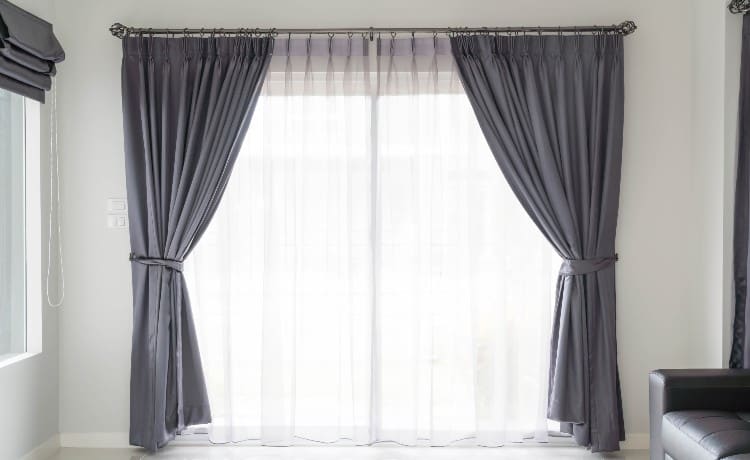When it comes to making curtains for my home, the first question I have to ask is: how much fabric do I need? The answer depends on the look I am going for and the style of curtains I want. But, where do I start? Can I use a curtain fabric calculator to tell how much fabric I need?
Measure the length and width of the window, making sure to allow for an overhang to cover the wall edge. Multiply this by the number of panels needed. Allow extra inches for seam allowances, hems, headers, and pleats. An easy way to calculate the amount of fabric needed is by using a curtain fabric calculator.
There’s a lot of things to consider. Do I want floor-length curtains? How many panels should I have? This article will answer those questions and show you how to use a curtain fabric calculator.
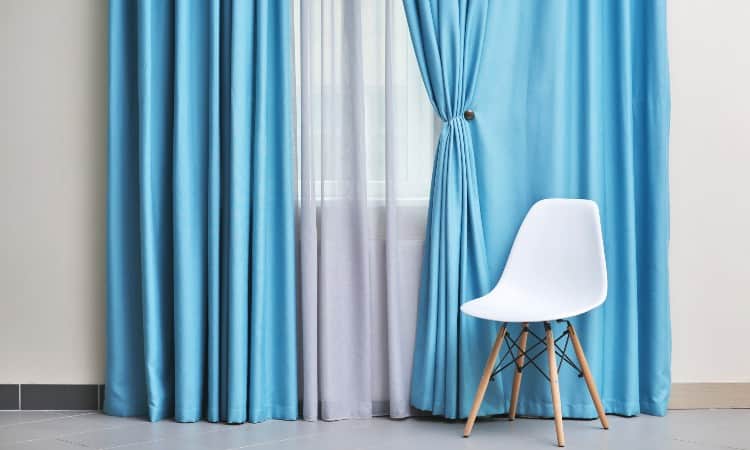
What to Consider Before Choosing Fabric for Curtains
When it comes to choosing fabric for curtains, there are a few things to keep in mind. The fabric you pick needs to coordinate with your room’s color scheme. You want to frame your window as a decorative feature, not have it stick out like a sore thumb.
Having curtains that complement your room’s aesthetics can enhance the overall look. But, there’s more to choosing a fabric than color alone. Let’s take a look at some other things to take into consideration when picking the material.
1. What Type of Curtains Do You Need?
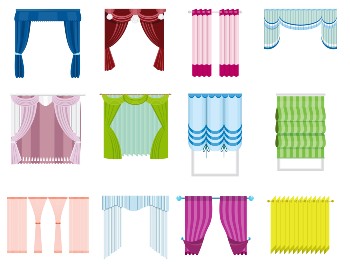 The style of curtain you are looking for will impact the type of fabric you need to purchase. Are the curtains going to be functional or decorative? Will they reach from floor to ceiling, or end at or just below the windowsill?
The style of curtain you are looking for will impact the type of fabric you need to purchase. Are the curtains going to be functional or decorative? Will they reach from floor to ceiling, or end at or just below the windowsill?
One thing to be careful of when deciding to go with floor-length curtains, watch for anything on your wall under the window. You don’t want the drop of your curtains to cover your radiators or wall heaters. Not only could that block heat into your room, but it could also be a fire hazard. Wall sockets are another thing to watch out for.
Curtains that will be opened and closed regularly will need a sturdy fabric that can withstand constant use. Decorative curtains designed to stay open to frame a window can be made from more lightweight fabric.
If your curtains will have pleats, you’ll need a fabric that can hold a fold. Similarly, sheer, lightweight curtains need a light, floaty fabric.
2. What Type of Fabric Are You Using?
 Your choice of fabric will dictate what curtain style you can go for. It’s no good using polyester if you want heavy, draft excluding blackout curtains. Nor is it worth getting an opulent floral, upholstery fabric if you want a sheer window dressing.
Your choice of fabric will dictate what curtain style you can go for. It’s no good using polyester if you want heavy, draft excluding blackout curtains. Nor is it worth getting an opulent floral, upholstery fabric if you want a sheer window dressing.
Also, consider where the curtains are going to be used. Is it an area with a lot of traffic? If you have pets or children, can the curtain fabric hide marks from sticky fingers and soggy paws? Or will the curtains need regular cleaning? Will the fabric withstand frequent washing or will it shrink? A lighter-weight fabric may not be up to the challenge of family life.
3. Do You Need a Valance?
A valance is a small decorative screen that fits across the top edge of a window. Its main function is to hide the curtain rail. Used with curtains, blinds, or by itself, a valance can match or contrast the window treatments it is paired with.
Valances are a personal choice and optional. If you are looking at including a valance, decide on the look you want and add the fabric needed to the overall yardage for the curtain project.
4. Are You Going for a Window Curtain Set?
A window set includes a pair of curtain panels, a valance, and tiebacks. The full set provides a formal, yet romantic window dressing option, particularly with floral fabrics.
Each added panel or tieback increases the amount of fabric you need. You’ll also need to consider if your chosen fabric is robust enough to make things like tiebacks. If it’s too lightweight, you may need to purchase them ready-made.
Coordinating with your main fabric is essential, so make sure to allow for tiebacks and valances when you buy your curtain fabric.
5. How About a Window Scarf?
A window scarf is a thin piece of material that drapes along the top of the window and down one or both sides. It’s thin and lightweight and is usually made from sheer fabrics like voile. A scarf can be used with sheer curtains or on its own.
The main function of a window scarf is decoration and enhancing existing curtains with a layered look. A bit like the valance, a window scarf is a personal preference and not essential.
It can look divine and add elegance to a window if used correctly. If it doesn’t match your main curtains, it can look heavy and cluttered. Make sure both curtain and scarf fabric complement each other before using both on your window.
6. Don’t Forget the Hem, Header, and Seams
Whenever you make curtains, you need to make sure you allow extra fabric for hems and headers. The hem is the neat edge at the bottom of each curtain panel. A header is the part of the curtain that fits on the curtain pole.
Hem lengths can vary. It depends on the drape of the curtain. The larger the hem, the heavier the base of the curtain will be. You can also add curtain weights. It all helps the curtains hang better. So make sure your hem is big enough to accommodate the added weights.
If you have an extra-wide window, you may have to join a couple of widths of fabric together. Remember to add fabric to allow for a seam allowance if you do.
7. How Thick Is the Curtain Pole You’re Using?
The size of your curtain pole will determine how large your header needs to be. Ideally, the header should hide the curtain pole. It should also hide the tabs or channel holding the curtain to the pole.
Don’t forget, as well as concealing the pole, you need to allow the fabric to create the channel or tabs. The amount you need to allow for will vary depending on the thickness of the pole. Going for a channel will require more fabric than tabs.
8. How Many Curtain Panels Do You Need?
 A curtain panel can be used by itself or as part of a pair. Sometimes, for larger windows, four panels or more can be used to span the width of the window. Especially when it comes to Bay windows. The curtains follow a curved curtain track, and the extra panels allow the curtains to bend with the track to follow the window.
A curtain panel can be used by itself or as part of a pair. Sometimes, for larger windows, four panels or more can be used to span the width of the window. Especially when it comes to Bay windows. The curtains follow a curved curtain track, and the extra panels allow the curtains to bend with the track to follow the window.
For smaller windows, you can use a single curtain panel. Hanging on one side or the other, a single panel should be big enough to cover the entire window.
A pair of curtains, or two panels, are hung so one is on each side of the window. This gives a framing effect and enhances the view through the window.
9. Do You Need a Curtain Liner?
Lining your curtains, especially if they are made from a lightweight fabric will help offer privacy and control the amount of lightentering a room. Having a lining is a personal choice.
Linings can also be used to keep a room either cool or warm, particularly if they are made from a fabric with thermal properties. This could be useful in areas where there are large variations in seasonal temperatures.
Curtain Fabric Calculator
A curtain fabric calculator is an easy way to work out how much fabric is needed to make curtains. Simply enter your window measurements into the boxes below and watch as the calculator does all the tricky computations for you. All you need to do is decide how you want your curtains to look and the curtain fabric calculator will do the rest.
How to Measure Fabric for Curtains
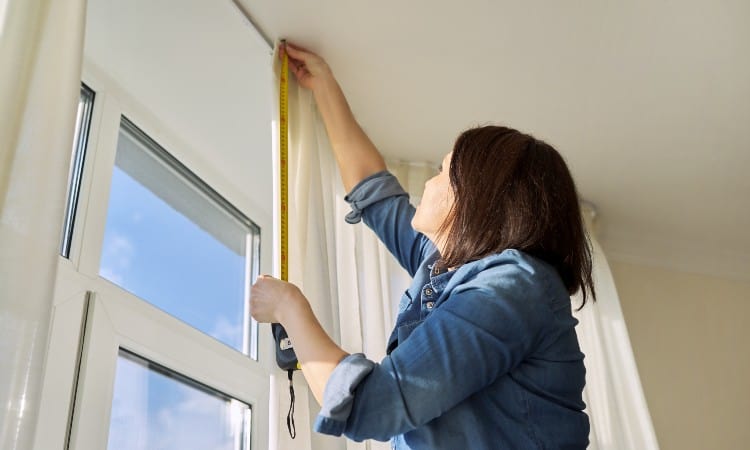
Before you can work out how much fabric you need for curtains, there are a couple of things you need to decide. The first is how you want your curtains to look. Should they be floor length? Do you want one panel or two?
Each design element will change the measurements of your window. From the addition of a large header to the allowance of fabric for pleats, make sure you know how you want your curtains to look. Preferably, before purchasing your fabric.
For Curtains Fitting Outside the Window Frame
Step 1
Measure the width of your window from one outside edge to the other. Then, measure the curtain pole. Your curtains need to be as wide as the pole is long. If the pole extends beyond the window frame by 3 inches on each side, add an extra 6 inches to your window width.
For fullness, the width measurement of the curtains should be at least double the width of your window. Aiming 2.5 times larger than your actual window, allows for extra volume and errors. If you are going for two panels, divide the overall measurement in half.
Step 2
Measure the drop of your curtains from the pole down to either the windowsill or the floor. The final length will depend on how long you want the curtains to be. This step is a lot easier if the pole is in place. If you haven’t fitted the pole yet, go from where you want the pole to be.
Decide how large you want the header to be. If you decide on a 3-inch header, make sure to add an extra 6 inches to the length of your curtain. This will allow enough fabric on the reverse side to form a sturdy band to act as an anchor point for curtain tabs or rings.
Step 3
Add extra fabric for seams and hems. Ideally, your bottom hemline should be at least 6 inches. This amount should be added to the overall length of your curtains.
For Curtains Fitting Inside the Window Frame
Step 1
Measure the window inside the casing widthways from one side to the other. Multiply this figure by between 1.5 and 2.5, depending on the amount of fullness you want.
Step 2
Next, measure from the top of the casement to the sill. Allow extra for hems and a header. For a 3 inch header, you will need to add an extra 6 inches to the length. In the same way, a 1-inch hem will need an allowance of 4 inches.
How To Calculate How Much Fabric I Need for Curtains?

Working out how much fabric you need for curtains starts with knowing the height and width of your window. You also need to consider how wide your preferred fabric is going to be. Matching the window may require joining more than one width of the fabric.
For instance, you have a window 120 inches wide, including an allowance for the fullness. You want two panels to cover the window. Dividing 120 by 2 gives two panels measuring 60 inches wide. The fabric you have chosen is only 35 inches wide.
Each panel will need two widths of fabric. The total width of the fabric will be 140 inches. Although this gives an extra 20 inches, some of this will be used in seam allowances to join the pieces together, and in the side hems. The rest will just add more fullness to the overall look of the curtains.
Example 1
For this example, let’s look at a window with a drop of 4ft and a width of 4ft. To make calculations a little easier, we’ll convert the feet to inches. Our window is 48 inches x 48 inches.
Firstly, multiply the width by 2.5 to allow for pleating and fullness. This gives a new width of 120 inches. Then, add extra to the drop for a heading and hem. We’ll add an extra 6 inches for both. Our new drop is 60 inches.
The fabric for this project is 60 inches wide. There is no pattern repeat so no extra fabric is needed for pattern matching. To span a window width of 120 inches, it will be necessary to purchase two widths of fabric and join them together.
To calculate the fabric for this example, multiply 60 (drop) x 2. This comes out at 120 inches which is equal to 10 feet or 3.33 yards. It’s always best to round up to be on the safe side. So the yardage needed for these curtains would be 4 yards.
Example 2
For the next example, we’ll look at patio doors. With a drop of 78 inches and a width of 32 inches. The fabric is 60 inches wide with a pattern repeat of 6 inches.
First, multiply the width by 2.5. This gives 80 inches. As the fabric is 60 inches wide, it will be necessary to buy 2 widths to cover the window. Next, add a header, hem, and allowance for a pattern repeat to the length. We started with a drop of 78, adding 6 inches for the pattern and another 12 inches for header and hems, we now have a drop of 96 inches.
To find the fabric yardage for this example, multiply 96 (drop) x 2. The result is 192 inches. Therefore, the yardage needed for this example is 5.33 yards. Rounded up, it means we need 6 yards for these curtains.
How Many Yards of Fabric for 84-Inch Curtains?
84-Inch Width
Let’s assume we know our window needs curtains with a width of 84 inches, including an allowance for fullness. The next thing to work out is the length or drop of the curtains.
The distance from the curtain pole to the floor is 78 inches. Allowing an extra 12 inches for a header and hem, our length is now 90 inches.
Next, we need to know the width of the fabric. Let’s go with 60 inches wide. Covering an 84-inch window will take two widths of the fabric.
Taking the length of 90 inches and multiplying it by 2, gives us 180 inches. This is equal to 15 feet, or 5 yards. In this example, curtains for a window 84 inches wide would need 5 yards of fabric.
84-Inch Length
If we change the drop of the curtains to 84 inches, this changes the yardage needed. Adding 12 inches for hems and a header gives us 96 inches.
We know the window is 84 inches wide and we need 2 widths of fabric to cover it. Our new calculation is 96 multiplied by 2 which equals 192 inches, or 16 feet.
In yards it comes out as 5.33. Rounding up to the next whole yard means these curtains would need 6 yards of fabric.
How Much Fabric Do I Need for 96-Inch Curtains?
96-Inch Width
For this example, the window is 96 inches wide with a drop of 54 inches. This time, we haven’t added any extra for fullness. Our first step is multiplying the width of 96 by 2.5. Fullness for curtains should be at least double the width of the window. Going 2.5 times bigger allows wriggle room for errors. Including fullness, the Curtains need to be 240 inches wide.
When calculating the drop of the curtains, there needs to be extra fabric for hems and a header. If we go for a 6-inch hem and 6-inch header and add this to the drop of 54 inches, the new length is 66 inches.
Using a fabric measuring 60 inches wide means we’ll need more than one width of fabric to cover the window. We calculated curtain fabric to be 240 inches wide. If we divide that by 60, it comes to 4. We need 4 widths of the fabric.
Multiplying the drop of 66 inches by 4 widths of fabric gives 264 inches. Converting this to feet is 22 feet. This is equal to 7.33 yards. It’s always best to round up to the next whole yard so these curtains will need 8 yards of fabric.
96-Inch Length
Now let’s look at curtains with a length of 96 inches. Allowing an extra 12 inches for header and hems, the new drop is 108 inches. Sticking with a fabric 60 inches wide, let’s assume the window measures 120 inches wide including fullness.
We’ll need more than one width of the fabric to span the window. If we divide 120 by 60, the result is 2. Multiplying the drop of 108 by 2 is 216 inches. The result is 18 feet or 6 yards. These curtains will need 6 yards of fabric.
How Many Yards of Fabric for 108-Inch Curtains?
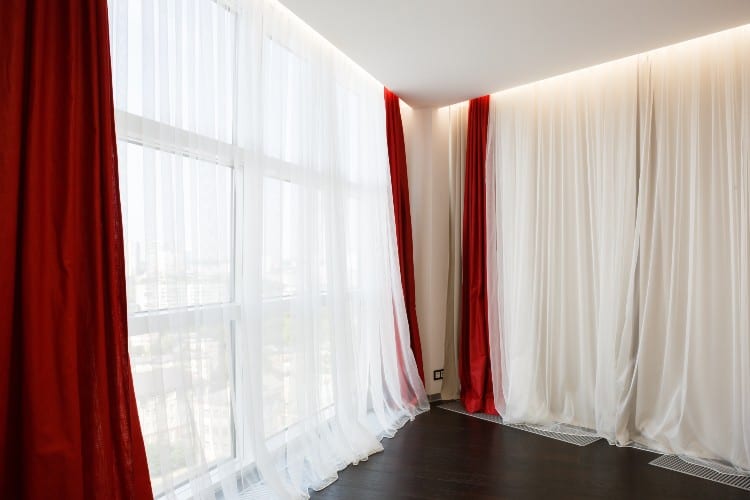
108-Inch Width
The window for this example is 108 inches wide, including an allowance for fullness. The drop is 54 inches with an extra 12 inches needed for hems and a header. This gives us a new drop of 66 inches.
Using a fabric 108 inches wide means we only need to buy one width of the material. Multiplying the drop of 66 inches by the number of fabric widths gives us 66 inches. This equals 5.5 feet or 1.83 yards. Rounding up to the next full yard means these curtains require 2 yards of fabric.
108-Inch Length
Adding a 12-inch allowance for hems and a header to a drop of 108, gives us a new curtain length of 120 inches. Let’s assume the width of the window is 108 inches before allowing for fullness. We’ll use a 60-inch wide fabric for this example.
When we multiply the window width by 2.5, it comes out at 270 inches. To span a window of this size will take more than one width of a 60-inch wide fabric. Dividing 270 by 60 gives a result of 4.5. This means we’ll need to round up to 5 widths of fabric.
The length of 120 inches multiplied by 5 widths of fabric, gives 600 inches. That’s equal to 50 feet or 16.66 yards. It’s always best to round up to the next whole yard. These curtains will need 17 yards of fabric.
Conclusion
Measuring fabric for curtains involves a lot of calculations. You need to know the width, length, and the amount of extra fabric needed for fullness, header, hems, and seams.
There’s a lot to remember. The curtain fabric calculator included in this article will handle the math for you. Making sure you get the right amount of material for your project.
Let me know in the comments if you liked the article. Have you tried the curtain fabric calculator? Has it encouraged you to embark on making your own curtains?
